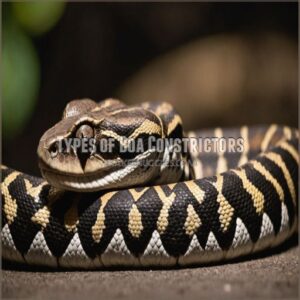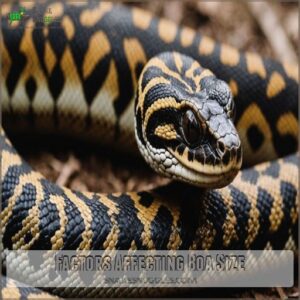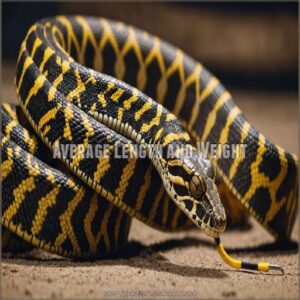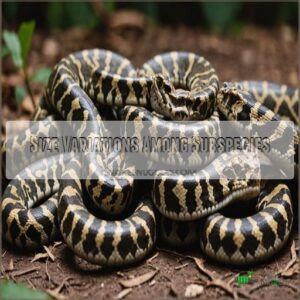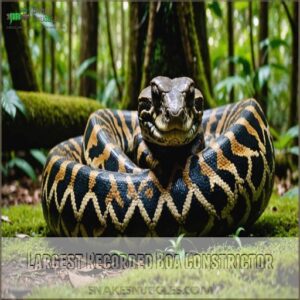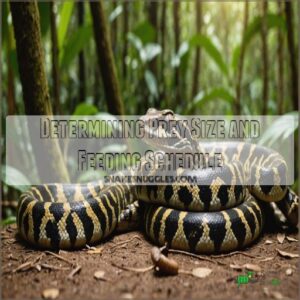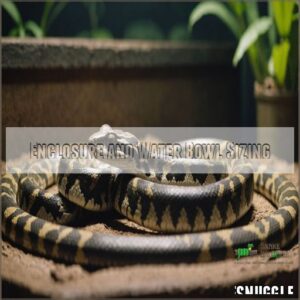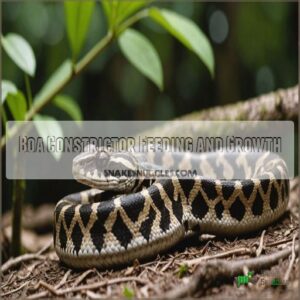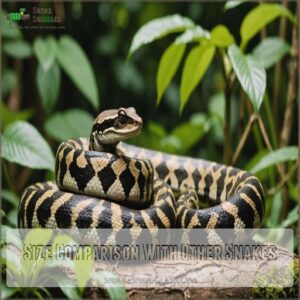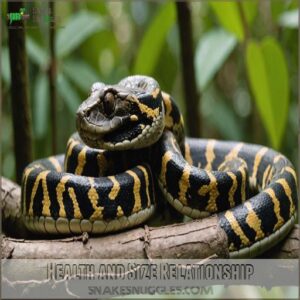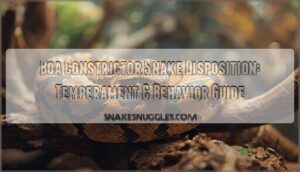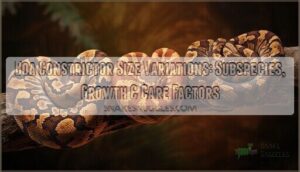This site is supported by our readers. We may earn a commission, at no cost to you, if you purchase through links.
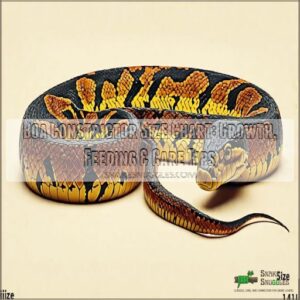 When you’re checking out a boa constrictor size chart, you’ll discover these fascinating reptiles can range from 20 inches to over 10 feet.
When you’re checking out a boa constrictor size chart, you’ll discover these fascinating reptiles can range from 20 inches to over 10 feet.
Dwarf boas are on the smaller end, while female red-tailed boas, known for their larger size, usually measure 6-10 feet.
Male boa constrictors typically reach 5-7 feet in length.
Their size isn’t just about genetics—it also depends on diet, habitat, and care.
Giant tales, like one famous boa reaching over 14 feet, show nature’s unpredictability.
So, if you’re curious about mastering boa care, understanding these size dynamics is key.
Ready for more intriguing boa facts?
Table Of Contents
- Key Takeaways
- Types of Boa Constrictors
- Factors Affecting Boa Size
- Boa Constrictor Size Chart
- Growth Rate and Timeline
- Determining Prey Size and Feeding Schedule
- Enclosure and Water Bowl Sizing
- Boa Constrictor Feeding and Growth
- Size Comparison With Other Snakes
- Health and Size Relationship
- Tracking Growth and Size
- Frequently Asked Questions (FAQs)
- How big do boa constrictors get?
- How big should a boa constrictor enclosure be?
- Are boa constrictors bigger than pythons?
- What is the longest boa constrictor ever seen?
- How big is a full grown boa constrictor?
- How big is a 1 year old boa?
- What is the friendliest boa?
- What is the maximum size of a boa snake?
- How often should boas be handled?
- What are signs of stress in boas?
- How do you measure a boa constrictors length?
- What signs indicate a healthy shedding process?
- Are boas legal to own everywhere?
- Conclusion
Key Takeaways
- You’ll see that boa constrictors range widely in size, with dwarf boas as small as 20 inches and female red-tailed boas reaching up to 10 feet.
- Boas’ growth depends on factors like diet and habitat; providing a proper environment ensures healthy development and potential longevity up to 20 years.
- When setting up an enclosure, consider that juvenile boas (2-5 feet) need a 4′ x 2′ x 2′ enclosure size. Be mindful of the differences among boa subspecies: red-tailed boas, dwarf boas, and boa constrictor imperators each have unique characteristics and size variations.
- Maintain a proper feeding schedule and enclosure setup, as these are crucial for supporting your boa’s health and preventing issues like obesity or stress.
Types of Boa Constrictors
When exploring the diverse world of boa constrictors, you’ll encounter varieties like the Red-Tailed Boas, Dwarf Boas, and the Boa Constrictor Imperator, each with unique traits and size differences.
Understanding these types helps you choose the right companion and properly manage their care and growth.
Red-Tailed Boas
If you’ve ever wondered about red-tailed boas, you’ll find they’re fascinating creatures.
They can be further divided into subtypes like the Boa constrictor imperator and the Boa constrictor constrictor, with the latter featuring a deeper red tail color.
These boas typically reach 6-10 feet in length, with females growing larger than males.
A rich, humid habitat helps maintain their vibrant coloration and health.
With proper care, they can live over 20 years, making understanding their growth rate and temperament key to successful red-tailed boa care.
Dwarf Boas
Dwarf boas are perfect if space is tight and you’re after low-maintenance pets. They’re smaller than other boas, reaching only about 20 inches for females.
To keep one healthy, you can find various boa constrictor habitat products online at boa constrictor supplies.
Focus on:
- Habitat: Provide a snug, warm enclosure.
- Diet: Feed appropriately sized prey weekly.
- Lifespan: Expect them to live up to 20 years with proper care.
Engaging with these petite yet intriguing reptiles offers a unique experience!
Boa Constrictor Imperator
Unlike smaller dwarf boas, the common boa constrictor imperator boasts impressive size.
Males typically reach 5-7 feet, while females grow larger, hitting 6-8 feet.
Their imperator care involves providing a spacious habitat.
You’ll need a feeding chart to guide you on their feeding habits.
Understanding their growth timeline and sexual dimorphism helps guarantee their well-being in captive breeding programs.
A long lifespan awaits your imperator boa with proper care.
Factors Affecting Boa Size
In terms of boa constrictor size, genetics play a significant role, but the environment and diet you provide also make a big difference.
Keep them warm and well-fed, but don’t go overboard, or you might end up with a snake that’s a little too hefty for its own good!
Genetics and Diet
When talking boa constrictors, genetics and diet pack a punch in shaping their size, with some species reaching lengths of over boa constrictor impressive lengths.
A boa’s growth depends on its genetic variation and dietary impact, so nail that feeding strategy!
You’ll notice that caring for a boa isn’t just snake care; it’s a dance between health and growth factors.
Understanding these aspects helps your boa stay healthy and vibrant.
Environmental Factors
Factors like humidity, lighting, and enclosure space greatly impact a boa’s size.
You need to make sure the substrate is comfortable and that water availability is plentiful.
Boas are opportunistic feeders, adjusting to seasonal changes, so understanding prey size is important.
This balance, a key element of boa constrictor husbandry, helps maintain their average weight and overall health.
Temperature and Metabolism
Boa constrictors require a temperature gradient, with a basking spot of around 90°F, as explained in boa constrictor tank setup. You know, boa constrictors need just the right temperature to thrive, as they’re cold-blooded creatures.
With proper heat regulation, their metabolic rate will function at its best, impacting their growth positively.
Without it, they might enter brumation, slowing everything down.
Handle your boa with care, monitor temperature to influence feeding frequency and observe their curious behavior for any changes.
Boa Constrictor Size Chart
Understanding the average weight of a boa constrictor, which is typically between 20 to 45 kilograms (45 to 100 pounds) as discussed in a detailed boa constrictor weigh guide, involves recognizing average lengths and weights, as well as variations among subspecies.
With some boas reaching over 9 feet and others topping at 14 feet, it’s important to distinguish between different types and the largest records.
Average Length and Weight
Boa constrictors often tip the scales at over 100 pounds, with males reaching lengths of 5-7 feet and females 6-8 feet. To accommodate their growth, it’s essential to choose the right enclosure size, such as the guidelines provided in the boa constrictor cage size guide.
Their growth is greatly impacted by sex differences and age, making females larger due to sexual dimorphism.
Regular reptile feeding is essential to avoid myths about boa size.
Thoughtful care guarantees your boas stay healthy.
Size Variations Among Subspecies
Several boa constrictor subspecies exist, each with unique size characteristics.
Island boa size, for example, often differs from mainland populations.
This variation stems from genetic differences and habitat impact.
Consider these key factors:
- Geographic range plays a major role in influencing size.
- Genetic diversity plays a key role.
- Conservation concerns highlight the importance of understanding these variations.
Largest Recorded Boa Constrictor
Curious about the largest boa constrictor ever recorded?
Historical records may surprise you with tales of giants.
One famous specimen, stretched over 14 feet, sparked debate due to misidentification as an anaconda.
Always verify records, and remember, myths about snake size abound.
Here’s a quick look at measurement methods:
| Specimen | Length (Feet) | Notes |
|---|---|---|
| Largest Recorded | 14.6 | Misidentified |
| Average Boa | 6.5-10 | Verified |
| Dwarf Boa | 1.5-2 | Subspecies variation |
| Measurement | Varied | Methods differ |
| Typical Length | 5-9 | Common range |
Growth Rate and Timeline
You’ll notice that boa constrictors experience rapid growth spurts in their first year, thanks to their voracious appetites and boundless energy.
By the time they reach three years old, they’re usually at or near maturity, fully embracing their majestic and formidable size.
Growth Spurts in The First Year
In the first year, your boa constrictor will experience growth spurts.
Between fluctuating feeding schedules and the right enclosures, you’ll witness impressive changes.
Here’s what to expect:
- Genetics play a big role in growth milestones.
- Temperature impacts metabolism and size.
- Proper feeding keeps growth on track.
- A well-sized, ideal enclosure supports health.
Growth Rate in Subsequent Years
After experiencing growth spurts in the first year, boa constrictors continue to grow steadily.
Proper feeding practices, such as feeding appropriately sized prey, impact their size considerably.
Incorrect feeding potentially leads to health issues.
Enclosure size and environment also influence growth, emphasizing the importance of proper care.
Male boas often grow to about 5-7 feet, while females can reach 6-8 feet, highlighting noticeable sex differences in size.
Time to Reach Full Size
As your boa grows, noticing a shift in growth rate is fascinating.
Between genetics, diet, and environment, boas typically reach maturity around three years.
Expect females to often be larger than males, thanks to sexual dimorphism.
Maturity indicators like size and weight vary, but if conditions are right, you’ll see your boa reach its full grandeur with predictable individual variations.
Determining Prey Size and Feeding Schedule
When feeding your boa constrictor, make sure the prey size aligns with the thickest part of its body, helping to prevent digestive issues.
Establishing a consistent feeding schedule based on temperature and activity levels can support your snake’s healthy growth.
Prey Size Guidelines
Imagine this: You’re carefully selecting your boa’s next meal.
The prey’s thickness shouldn’t exceed your snake’s body at its widest point.
This simple guideline minimizes digestive impact, essential during growth phases.
Consider the prey type: age factor plays a role too.
Remember, a slightly smaller meal is better than one too large.
Proper prey sizing helps your boa thrive!
Feeding Frequency and Schedule
You’re probably wondering how often to feed your boa.
Once you’ve nailed down prey size, focus on meal frequency.
Here’s a handy guide:
- Growth rate matters: Feed babies every 5-7 days.
- Seasonal variations impact feeding: Adults eat every 7-10 days.
- Fasting periods: Adjust feeding if your snake shows reluctance.
Adjusting Prey Size and Schedule
Adjusting prey size and schedule helps your boa stay healthy and happy, aligning with its growth stages.
Choose prey slightly smaller than the boa’s thickest part.
Feeding frequency varies with temperature—more in warm months, less in cooler ones.
Keep a feeding log to monitor health and growth, making changes as needed for the best care.
Enclosure and Water Bowl Sizing
When setting up a home for your boa constrictor, choosing the right enclosure size guarantees your pet’s comfort and health.
Don’t forget a water bowl that’s ample enough for soaking, keeping your boa happy and hydrated.
Ideal Enclosure Size for Juveniles
Considering the right prey size is one step, next think about your boa’s home.
A juvenile thrives in a 4x2x2-foot setup.
Keep these tips in mind:
- Substrate Choice: Use easy-to-clean substrates.
- Heating Requirements: Maintain 80-92°F.
- Ventilation Importance: Make sure there’s good airflow.
- Water Bowl: Provide a bowl for soaking to make sure the snake stays hydrated.
Ideal Enclosure Size for Adults
As your boa constrictor matures, their living space needs an upgrade.
An adult’s enclosure should measure 8 feet long, 4 feet wide, and 4 feet high.
You can find ideal enclosures for your boa constrictor, such as boa constrictor enclosures, that cater to their specific needs.
Use sturdy enclosure materials, and prioritize excellent ventilation to regulate humidity levels.
Maintain proper heating to mimic their natural habitat, and choose a substrate that’s comfortable and easy to clean.
Water Bowl Size and Depth
Choosing the right water bowl for your boa is essential—think of it as equipping them with their personal spa.
Opt for a wide, stable bowl that’s hard to tip over, allowing the boa to soak or sip comfortably.
Make sure the bowl is shallow enough to prevent any trapping hazards, and be sure to clean it frequently to maintain hygiene.
Boa Constrictor Feeding and Growth
You’ll find that a boa constrictor’s growth is closely tied to its diet; consistent, properly sized meals are key to a healthy, thriving snake, avoiding both underfeeding and the pitfalls of obesity.
Regularly tracking your boa’s feeding schedule and weight helps you guarantee good growth and spot any potential health problems early on.
Feeding Frequency and Growth
When planning your boa’s home, also think about feeding frequency.
With the right meal schedule, you’ll boost healthy growth stages.
A general rule of thumb is to feed young boas every 5-7 days and adjust as they grow, according to a boa constrictor feeding schedule.
Here’s how:
- Prey size matched to the boa’s width
- Regular weight tracking
- Strategize meal frequency based on growth
- Overfeeding risks? Avoid by checking lump size
- Smaller, frequent meals work better than fewer, large meals.
Overfeeding and Obesity
Feeding your boa constrictor the right amount is like walking a tightrope.
Too much can lead to obesity, bringing health risks and impacting their metabolism.
Think about dietary changes to maintain a good body condition score.
Overfeeding can have long-term effects, so keep an eye on your boa’s waistline—after all, you can’t have your snake and eat it too!
Importance of a Feeding Log
After addressing overfeeding concerns, you should keep a feeding log for your boa. This helps track growth, monitor health, and spot trends.
Here’s why it’s key:
- Record each meal to identify any issues.
- Monitor diet adjustments for health monitoring.
- Use it as a guide to guarantee proper nutrition and happy herping!
Size Comparison With Other Snakes
When you’re comparing boa constrictors to other snakes, you’ll notice they fall somewhere in the middle—bigger than corn snakes but smaller than anacondas.
Pythons, on the other hand, can often outgrow boas, with some species reaching impressive lengths that make even a mature boa look compact.
Boa Constrictors Vs Pythons
You’re curious about boa constrictors and pythons, eh?
While neither has venom, both excel in hunting.
Boa constrictors are generally smaller, often found in varied habitats, and have a calm temperament.
Pythons, including Burmese and reticulated, usually outgrow boas.
Their lifespan varies with care.
| Snake Type | Size (Feet) | Typical Habitat |
|---|---|---|
| Boa Constrictor | 6-9 | Rainforests, Woodlands |
| Burmese Python | 12-20 | Forests, Grasslands |
| Reticulated Python | 15-25 | Rainforests, Near Water |
Boa Constrictors Vs Anacondas
When comparing boa constrictors to anacondas, you’ll notice anacondas take the cake as the heavyweight champs.
Anacondas, known for their hefty size, can grow over 20 feet long, while boas typically max out at 10 feet.
Both snakes share similar habitats and prey, but boas have a more laid-back temperament.
Unlike other snakes, neither possess venom.
Boa Constrictors Vs Other Snake Species
Anacondas are giants, right? But how do boas stack up against other snakes?
Burmese pythons and reticulated pythons easily outsize boa constrictors.
Size varies wildly depending on the boa subspecies and gender.
Female boas are usually larger than males.
For a more accurate size comparison, check out the size difference between boa constrictor vs ball python size.
This size difference, called sexual dimorphism, is common in many snake species.
Remember, a boa’s size depends on its diet and environment too.
Understanding these factors helps you better care for your snake.
Health and Size Relationship
Understanding the relationship between your boa constrictor’s health and size is essential for ensuring its well-being. A boa constrictor’s size can be significantly impacted by proper feeding, with guidelines for prey size and feeding schedules available in a comprehensive boa constrictor care sheet.
By monitoring their weight and appearance, you can prevent both obesity and undernourishment, keeping your snake in top condition.
Signs of a Healthy Boa Constrictor
Spotting a healthy boa constrictor isn’t tricky if you know what to look for.
They should have a smooth shedding process, maintaining clear eyes and firm body condition.
Keep an eye on their active behavior and strong appetite as signs of vitality.
Consistent eye clarity also indicates good health.
Check these regularly, and you’ll guarantee your boa stays in tip-top shape.
Signs of an Overweight or Underweight Boa
Noticing when your boa’s health is off track can be tricky, but you’re on it!
Look for these signs:
- Signs of obesity: Watch for rounded bodies and fat rings.
- Protruding spine: This indicates being underweight.
- Reduced muscle tone: Means it’s time to adjust feeding.
A balanced diet helps your boa stay well within a healthy range.
Importance of Monitoring Health and Size
After identifying your boa’s weight category, you can focus on keeping it healthy.
Regularly monitor its size and health because its growth reflects both feeding and environment.
A plump boa with sluggish movement might hint at overfeeding.
A lanky body could signal an issue. Keeping track helps you make sure a long, happy lifespan for your serpent friend.
Tracking Growth and Size
When you’re tracking your boa constrictor’s growth, a feeding log and regular measurements of weight and length are essential tools.
Keeping tabs on these factors helps you spot any unusual changes in eating habits, ensuring your boa constrictor stays healthy and happy.
Keeping a Feeding Log
Keeping tabs on your boa’s health connects back to maintaining a balanced diet.
Tracking with a feeding log benefits you by turning growth into a science project.
Log meal size, feeding frequency, and weight changes neatly.
You’ll find:
- Peace of mind knowing your boa’s diet is balanced.
- Quick identification of any unusual patterns.
- Valuable data for future reference.
Monitoring Weight and Length
That feeding log’s a great start! Now, let’s talk weight and length. Regular weigh-ins and measuring are key for tracking your boa’s growth. Use a gram scale and a flexible measuring tape. Growth charts can help you compare your boa’s progress to average size.
Consistent monitoring helps you spot potential problems early.
Remember, weight monitoring is a crucial health indicator. It’s like keeping tabs on your own weight – it’s all about staying healthy!
Identifying Changes in Eating Habits
Noticing changes in your boa’s eating habits can signal important information. It may hint at stress, illness, or a shift in prey preference.
For good feeding, explore suitable boa constrictor food options here for boa constrictor meals.
Track these to make certain your pet’s thriving:
- Refusal to eat—Can indicate stress or improper environment.
- Sudden appetite decline—Consider potential illness.
- Preference changes—Try offering different prey.
- Frequency alterations—Adjusting the schedule can help.
Frequently Asked Questions (FAQs)
How big do boa constrictors get?
Imagine a tree growing taller with time; boa constrictors follow a similar path.
Males reach 5-7 feet, females 6-8 feet, with the largest topping 14 feet.
Size varies with age, subspecies, and environment.
How big should a boa constrictor enclosure be?
Your boa constrictor needs a spacious home to thrive.
Aim for an enclosure measuring 8 feet long, 4 feet wide, and 4 feet high for adults.
Larger space prevents stress and allows for healthier growth and movement.
Are boa constrictors bigger than pythons?
No, Burmese pythons and reticulated pythons are generally much larger than boa constrictors. Anacondas also dwarf boas. Boa constrictors, including common boa and red-tail boa species, can live up to 30 years with proper socialization as outlined in beginner boa constrictor care. However, boa constrictors are still impressively large snakes.
What is the longest boa constrictor ever seen?
The longest boa constrictor ever recorded measured about 14 feet.
However, it was mistakenly identified as an anaconda, not a common occurrence.
Most boas top out around 9-10 feet, with females generally being larger than males.
How big is a full grown boa constrictor?
Imagine a creature as long as a car! A full-grown boa constrictor can stretch between 5 and 8 feet, sometimes weighing over 100 pounds. Females are often larger, reaching up to 10 feet.
How big is a 1 year old boa?
At one year old, your boa constrictor typically measures around 3 to 4 feet, given a healthy diet and suitable habitat.
Embrace this growth as it’s just the beginning of their journey to adulthood.
What is the friendliest boa?
You wouldn’t believe it, but Colombian rainbow boas are often called the friendliest boas.
They’re known for their even temperaments, especially with consistent handling, making them a great option if you’re looking for a more docile snake.
What is the maximum size of a boa snake?
Boa snakes can grow impressively large, with females reaching up to 10 feet.
Male boas generally measure 5 to 7 feet.
However, the largest recorded boa was around 14 feet, but was mistaken for an anaconda.
How often should boas be handled?
Handling your boa constrictor 2-3 times weekly helps it adapt to interaction, but remember, each session should be short.
Avoid handling after feeding or during shedding, as this can stress the snake or cause health issues.
What are signs of stress in boas?
Watch for unusual behavior; lethargic movements, refusal to eat, or excessive hiding signal stress. A stressed boa might also exhibit skin discoloration or respiratory changes. These signs warrant immediate attention.
How do you measure a boa constrictors length?
Measure your boa’s length by gently stretching it along a soft, flexible tape measure laid flat.
Make sure the snake is comfortable and relaxed to get an accurate reading, starting from the head to the tail tip.
What signs indicate a healthy shedding process?
Your boa’s healthy shedding shows when its eyes go opaque, turning blue-grey, then clear up, and the skin comes off in one piece.
Increasing humidity helps, preventing issues like stuck skin or eye caps.
Are boas legal to own everywhere?
Boas aren’t legal everywhere, as laws vary across regions.
Some places restrict or ban them due to ecological concerns or safety.
Before adopting a boa, check local regulations to make sure you’re in compliance with legal requirements.
Conclusion
Think of a boa constrictor size chart as a roadmap guiding you through understanding these amazing snakes.
Knowing their growth patterns and the factors shaping their size lets you care for your boa better, ensuring it thrives.
As you learn about feeding, environment, and health, you can provide the ideal conditions for your pet’s development.
Stay informed, keep track of their progress, and you’ll have a happy, healthy boa constrictor companion.

